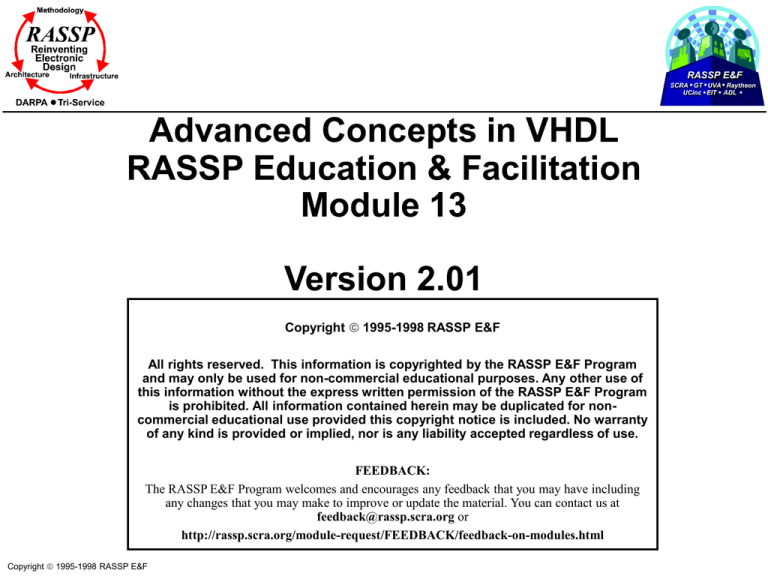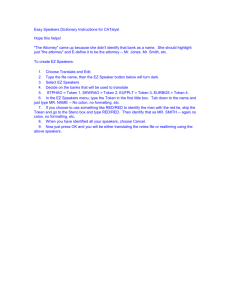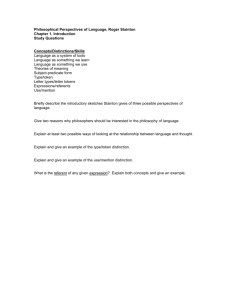
RASSP E&F
SCRA GT UVA Raytheon
UCinc EIT ADL
Advanced Concepts in VHDL
RASSP Education & Facilitation
Module 13
Version 2.01
Copyright 1995-1998 RASSP E&F
All rights reserved. This information is copyrighted by the RASSP E&F Program
and may only be used for non-commercial educational purposes. Any other use of
this information without the express written permission of the RASSP E&F Program
is prohibited. All information contained herein may be duplicated for noncommercial educational use provided this copyright notice is included. No warranty
of any kind is provided or implied, nor is any liability accepted regardless of use.
FEEDBACK:
The RASSP E&F Program welcomes and encourages any feedback that you may have including
any changes that you may make to improve or update the material. You can contact us at
feedback@rassp.scra.org or
http://rassp.scra.org/module-request/FEEDBACK/feedback-on-modules.html
Copyright 1995-1998 RASSP E&F
RASSP Roadmap
RASSP E&F
SCRA GT UVA Raytheon
UCinc EIT ADL
RASSP DESIGN LIBRARIES AND DATABASE
Primarily
software
HW
DESIGN
SYSTEM
DEF.
FUNCTION
DESIGN
HW &
SW
PART.
H/W & S/W
CODESIGN
VHDL
Copyright 1995-1998 RASSP E&F
Primarily
hardware
VIRTUAL PROTOTYPE
HW
FAB
INTEG.
& TEST
SW
DESIGN
SW
CODE
Module Goals
RASSP E&F
SCRA GT UVA Raytheon
UCinc EIT ADL
To expand on the syntax and semantics of
constructs introduced in prior modules to
highlight their flexibility
To introduce new features of VHDL beyond the
scope of the previous introductory modules
Copyright 1995-1998 RASSP E&F
Outline
RASSP E&F
SCRA GT UVA Raytheon
UCinc EIT ADL
Introduction
Revisiting Some VHDL Constructs
Aliases
Foreign
Interfaces
Files
TEXTIO
Assert
Statements
Processes
Signal Assignment Statements
Shared Variables
Copyright 1995-1998 RASSP E&F
Outline (cont.)
RASSP E&F
SCRA GT UVA Raytheon
UCinc EIT ADL
Examples
Abstract
Data Type Example
Example
From UVA ADEPT
Summary
Copyright 1995-1998 RASSP E&F
Advantages of Using VHDL
RASSP E&F
SCRA GT UVA Raytheon
UCinc EIT ADL
VHDL offers several advantages to the designer
Standard
language
Readily available tools
Powerful and versatile description language
Multiple mechanisms to support design hierarchy
Versatile design reconfiguration support
Support for multiple levels of abstraction
Copyright 1995-1998 RASSP E&F
Outline
RASSP E&F
SCRA GT UVA Raytheon
UCinc EIT ADL
Introduction
Revisiting Some VHDL Constructs
Aliases
Foreign Interfaces
TEXTIO
Assert Statements
Processes
Signal Assignment
Shared Variables
Examples
Summary
Copyright 1995-1998 RASSP E&F
Statements
Fundamental View of VHDL
RASSP E&F
SCRA GT UVA Raytheon
UCinc EIT ADL
Fundamentally, VHDL follows event-driven
concurrent execution semantics :
ARCHITECTURE arch_label OF ent_label IS
[architecture_declarations]
BEGIN
[block_statement] |
[process_statement] |
[concurrent_procedure_call_statement] |
[concurrent_assertion_statement] |
[concurrent_signal_assignment_statement] |
[component_instantiation_statement] |
[generate_statement]
END [arch_label];
Sequential
execution available inside processes
Note component instantiations are concurrent statements
Copyright 1995-1998 RASSP E&F
Aliases
RASSP E&F
SCRA GT UVA Raytheon
UCinc EIT ADL
Aliases can significantly improve the readability of
VHDL descriptions by using a shorthand notation
for names
Aliases allow reference to named items in different
ways:
ALIAS Data_Bus: MVL_Vector(7 DOWNTO 0) is
Data_Word(15 DOWNTO 8);
Aliases can rename any named item except labels,
loop parameters, and generate parameters
Copyright 1995-1998 RASSP E&F
Alias
An Example
An alias of an overloaded subprogram or literal
requires a signature to determine the correct
value to return
TYPE mvl IS ('U', '0', '1', 'Z');
TYPE trinary IS ('0', '1', 'Z');
ALIAS mvl0 IS '0' [RETURN mvl];
ALIAS tri0 IS '0' [RETURN trinary];
PROCEDURE preset_clear(SIGNAL drv: mvl_vector;
pc_value: INTEGER);
PROCEDURE preset_clear(SIGNAL drv: BIT_VECTOR;
pc_value: INTEGER);
ALIAS pcmvl IS preset_clear(mvl_vector, INTEGER);
ALIAS pcbit IS preset_clear(BIT_VECTOR, INTEGER);
Copyright 1995-1998 RASSP E&F
RASSP E&F
SCRA GT UVA Raytheon
UCinc EIT ADL
Foreign Interfaces
RASSP E&F
SCRA GT UVA Raytheon
UCinc EIT ADL
Model description may include portions written in
a foreign programming language (e.g. C)
Subprogram
or architecture body can be described in
programming language other than VHDL
Designer can incorporate previously written code or
code that is difficult to write in VHDL
Details on use of foreign code is largely
implementation dependent
Not possible to include variables, signals, or
entities described in a foreign language
ATTRIBUTE FOREIGN OF name: construct IS
"information/parameters";
Copyright 1995-1998 RASSP E&F
Foreign Interfaces
An Example
RASSP E&F
SCRA GT UVA Raytheon
UCinc EIT ADL
ENTITY and2 IS
PORT(a, b: IN BIT;
c: OUT BIT);
END and2;
ARCHITECTURE c_model OF and2 IS
ATTRIBUTE FOREIGN OF c_model:
ARCHITECTURE IS "xxand2(A, B, C)";
BEGIN
END c_model;
The c_model architecture is declared as FOREIGN
No
statements are needed in the architecture body as they will
never be executed
The implementation calls the "xxand2" function to perform the
actions for the and2 entity
Copyright 1995-1998 RASSP E&F
Files
RASSP E&F
SCRA GT UVA Raytheon
UCinc EIT ADL
VHDL defines a file object, associated types, and
certain limited file operations
TYPE file_type IS FILE OF type_mark;
PROCEDURE READ(FILE identifier : file_type; value : OUT type_mark);
PROCEDURE WRITE(FILE identifier : file_type; value : IN type_mark);
FUNCTION ENDFILE(FILE identifier : file_type) RETURN BOOLEAN;
File declarations
VHDL87
FILE identifier : file_type IS [mode] “file_name”;
VHDL93
FILE identifier : file_type [[OPEN mode] IS “file_name”];
Copyright 1995-1998 RASSP E&F
File Opening and Closing
RASSP E&F
SCRA GT UVA Raytheon
UCinc EIT ADL
In VHDL87, files are opened and closed when the
associated file object comes into and goes out of
scope
In VHDL93, files can be opened in the declaration
or predefined procedures can be used:
PROCEDURE FILE_OPEN(FILE identifier:file_type;
file_name: IN STRING;
open_kind: FILE_OPEN_KIND := READ_MODE);
PROCEDURE FILE_OPEN(status: OUT FILE_OPEN_STATUS;
FILE identifier: file_type;
file_name: IN STRING;
open_kind: FILE_OPEN_KIND := READ_MODE);
PROCEDURE FILE_CLOSE(FILE identifier: file_type);
Copyright 1995-1998 RASSP E&F
Text Input and Output
RASSP E&F
SCRA GT UVA Raytheon
UCinc EIT ADL
Basic file operations in VHDL are limited to
unformatted input/output
VHDL includes the TEXTIO package for input and
output of ASCII text
TEXTIO
is located in the STD library
USE STD.TEXTIO.ALL;
The following data types are supported by the
TEXTIO routines:
Bit,
Bit_vector
Boolean
Character, String
Integer, Real
Time
Copyright 1995-1998 RASSP E&F
TEXTIO Procedures
RASSP E&F
SCRA GT UVA Raytheon
UCinc EIT ADL
TEXTIO defines a LINE data type
All
read and write operations use the LINE type
TEXTIO also defines a FILE type of TEXT for use
with ASCII text
Procedures defined by TEXTIO are:
READLINE(f,k)
reads a line of file f and places it in buffer k
READ(k,v,...)
reads a value of v of its type from k
WRITE(k,v,...)
writes value v to LINE k
WRITELINE(f,k)
writes k to file f
ENDFILE(f) returns TRUE at the end of FILE
Copyright 1995-1998 RASSP E&F
Using TEXTIO
RASSP E&F
SCRA GT UVA Raytheon
UCinc EIT ADL
Reading from a file
READLINE
reads a line from the file into a LINE buffer
READ gets data from the buffer
Writing to a file
WRITE
puts data into a LINE buffer
WRITELINE writes the data in the LINE buffer to file
READ and WRITE have several formatting
parameters
Right
or left justification
Field width
Unit displayed (for time)
Copyright 1995-1998 RASSP E&F
TEXTIO
An Example
RASSP E&F
SCRA GT UVA Raytheon
UCinc EIT ADL
This procedure displays the current state of a FSM
USE STD.TEXTIO.ALL;
TYPE state IS (reset, good);
PROCEDURE display_state (current_state : IN state) IS
VARIABLE k : LINE;
FILE flush : TEXT IS OUT "/dev/tty";
VARIABLE state_string : STRING(1 to 7);
BEGIN
CASE current_state IS
WHEN reset => state_string := "reset ";
WHEN good => state_string := "good
";
END CASE;
WRITE (k, state_string, LEFT, 7);
WRITELINE (flush, k);
END display_state;
Copyright 1995-1998 RASSP E&F
Assert Statement
RASSP E&F
SCRA GT UVA Raytheon
UCinc EIT ADL
ASSERT statements are used to print messages
at the simulation console when specified runtime
conditions are met
ASSERT statements defined one of four severity
levels :
Note
-- relays information about conditions to the user
Warning -- alerts the user to conditions that are not
expected, but not fatal
Error -- relays conditions that will cause the model to
work incorrectly
Failure -- alerts the user to conditions that are
catastrophic
Copyright 1995-1998 RASSP E&F
Assert Statements
RASSP E&F
SCRA GT UVA Raytheon
UCinc EIT ADL
Syntax of the ASSERT statement
ASSERT condition
REPORT “violation statement”
SEVERITY level;
When the specified condition is false, the ASSERT
statement triggers and the report is issued
The violation statement is enclosed in quotes
ASSERT NOT((s=‘1’) AND (r=‘1’))
REPORT “Set and Reset are both 1”
SEVERITY ERROR;
Copyright 1995-1998 RASSP E&F
Assert Statements
An Example
RASSP E&F
SCRA GT UVA Raytheon
UCinc EIT ADL
This code has similar functionality to that of the
TEXTIO example
Assume
good = ‘1’, reset = ‘0’
PROCEDURE display_state (current_state : IN state) IS
BEGIN
ASSERT NOT(current_state = good)
REPORT “Status of State: good”
SEVERITY NOTE;
ASSERT NOT(current_state = reset)
REPORT “Status of State: reset”
SEVERITY WARNING;
END display_state;
Possible actions associated with the various
SEVERITY levels are simulator dependent
E.g.
Copyright 1995-1998 RASSP E&F
simulation may stop if a FAILURE assertion triggers
Processes Revisited
RASSP E&F
SCRA GT UVA Raytheon
UCinc EIT ADL
Complete PROCESS declaration syntax :
[process_label :]
[POSTPONED] PROCESS [sensitivity_list)] [IS]
process_declarative_part
BEGIN
process_statement_part
END [POSTPONED] PROCESS [process_label];
A process with no signal assignment statements
within it or its procedures is a passive process
Passive
processes may appear in entity declarations
Execution of postponed processes (new to VHDL93) :
Triggered
in the simulation cycle in which its sensitivity_list
or wait statement conditions are satisfied
Execute on the last delta cycle of the corresponding
simulation time
May not generate additional delta cycles in its execution
Copyright 1995-1998 RASSP E&F
Processes Revisited (Cont.)
RASSP E&F
SCRA GT UVA Raytheon
UCinc EIT ADL
Concurrent procedure call equivalent to process
containing a corresponding procedure call
[call_label :] [POSTPONED] procedure_call;
Concurrent assertion statement equivalent to a
passive process containing a corresponding
assertion statement
[assert_label :] [POSTPONED] assertion;
Concurrent signal assignments may also be
postponed
[label :] [POSTPONED] signal_assigment;
Copyright 1995-1998 RASSP E&F
Signal Assignment Statements
Revisited (Cont.)
RASSP E&F
SCRA GT UVA Raytheon
UCinc EIT ADL
Signal assignment statement syntax :
[label :] target <= [delay_mechanism] waveform;
Delay_mechanism
TRANSPORT
is either :
all input events reflected on output
REJECT time_expression INERTIAL
used to model component inertia so that short pulses
on input signals do not affect the target output
default delay_mechanism if none is specified
-- default condition further specifies that the
provided propagation delay be used for both the
REJECT and INERTIAL delays in the assignment
Copyright 1995-1998 RASSP E&F
Signal Assignment Statements
Revisited (Cont.)
RASSP E&F
SCRA GT UVA Raytheon
UCinc EIT ADL
Concurrent signal assignment syntax:
[label :] [POSTPONED] [GUARDED] conditional_signal_assignment
| [label :] [POSTPONED [GUARDED] selected_signal_assignment
A
postponed concurrent signal assignment statement is
equivalent to a one line postponed process
Example conditional signal assignment statement :
S3 <= 0 AFTER 2 ns WHEN (x=‘0’ and y=‘0’) ELSE
1 AFTER 5 ns WHEN (x=‘1’ and y=‘1’) ELSE
2 AFTER 8 ns;
Example
selected signal assignment statement :
WITH sel_signal
S3 <= 0 AFTER 3
1 AFTER 4
2 AFTER 5
UNAFFECTED
Copyright 1995-1998 RASSP E&F
SELECT
ns WHEN 0,
ns WHEN 3,
ns WHEN OTHERS;
may be used as the assignment value
No event is assigned to output -- New for VHDL93
Signal Assignment Statements
Revisited (Cont.)
RASSP E&F
SCRA GT UVA Raytheon
UCinc EIT ADL
Concurrent signal assignment : (cont.)
If
the target of the assignment is a signal of kind bus or
register, it is a guarded target -- available inside blocks
If the keyword GUARDED appears in the signal
assignment statement, there are two possibilities
for the assignment semantics :
For guarded targets :
if GUARD then
signal_transform
else
disconnect_statements
end if;
For non-guarded targets :
if GUARD then
signal_transform
end if;
Copyright 1995-1998 RASSP E&F
Signal Assignment Statements
Revisited (Cont.)
RASSP E&F
SCRA GT UVA Raytheon
UCinc EIT ADL
Sequential signal assignment statement :
No
mechanisms for guarded, postponed, conditional, or
selected signal assignments
No guarded statements because blocks are
concurrent rather than sequential statements
No postponed statements because sequential signal
assignment statements are NOT equivalent to one
line processes
No conditional or selected signal assignment
statements because their function is provided by
other means in sequential statements
e.g. IF-THEN_ELSE and CASE statements
UNAFFECTED
not allowed as an assignment value
Not needed since no conditional or selected
assignment statements are available
Copyright 1995-1998 RASSP E&F
Named Associations
RASSP E&F
SCRA GT UVA Raytheon
UCinc EIT ADL
Any index or parameter can be associated by
position or by name
Assignments
to elements in records in arrays can use
“|” and “OTHERS” :
TYPE array_ex IS ARRAY (1 TO 3) OF INTEGER;
VARIABLE var_pos : array_ex := (12,34,5);
VARIABLE var_nam1 : array_ex := (3=>23,2=>14,1=>8);
VARIABLE var_nam2 : array_ex := (1|3=>11,OTHERS=>15);
Port
Map and Generic Map associations can use
“OPEN” :
ENTITY dff is
PORT(d,clk,enable : IN level;
qn,q : OUT level);
END dff;
r0 : ENTITY work.dff(behav)
PORT MAP (d0,clk,q=>q0,qn=>OPEN,enable=>enabled);
Copyright 1995-1998 RASSP E&F
Shared Variables
RASSP E&F
SCRA GT UVA Raytheon
UCinc EIT ADL
In VHDL87, the scope of a variable was limited to
the process in which it was declared
Signals
were the only means of inter-process
communication
VHDL93 introduced the shared variable
Available
to many processes or procedures
Shared variables are useful for system level
modeling or object-oriented programming
Shared
variables also introduce some non-determinism
in VHDL, limiting the uses of this new construct
Copyright 1995-1998 RASSP E&F
Shared Variables
Non-determinism
ARCHITECTURE non_determinist OF example IS
SHARED VARIABLE count : INTEGER;
BEGIN
p1 : PROCESS
BEGIN
count := 1;
WAIT;
END PROCESS p1;
p2 : PROCESS
BEGIN
count := 2;
WAIT;
END PROCESS p2;
END non_determinist;
The final value of count is unpredictable
Copyright 1995-1998 RASSP E&F
RASSP E&F
SCRA GT UVA Raytheon
UCinc EIT ADL
Shared Variables
Stack Example
A shared variable is best used for system level
modeling and object-oriented programming
The following stack_of_integer package uses
shared variables to make the stack available to
more than one procedure
PACKAGE stack_of_integer IS
PROCEDURE push (what : IN INTEGER);
PROCEDURE pop (what : OUT INTEGER);
END stack_of_integer;
Copyright 1995-1998 RASSP E&F
RASSP E&F
SCRA GT UVA Raytheon
UCinc EIT ADL
Shared Variables
Stack Example
PACKAGE BODY stack_of_integer IS
TYPE stack_type IS ARRAY (0 TO 100) OF INTEGER;
SHARED VARIABLE stack : stack_type;
SHARED VARIABLE index : NATURAL := 0;
PROCEDURE push (what : IN INTEGER) IS
BEGIN
stack(index) := what;
index := index + 1;
END push;
PROCEDURE pop (what : OUT INTEGER) IS
BEGIN
index := index - 1;
what := stack(index);
END pop;
END stack_of_integer;
Copyright 1995-1998 RASSP E&F
RASSP E&F
SCRA GT UVA Raytheon
UCinc EIT ADL
Outline
RASSP E&F
SCRA GT UVA Raytheon
UCinc EIT ADL
Introduction
Revisiting Some VHDL Constructs
Examples
Abstract
Data Type Example
Example
From UVA ADEPT
Summary
Copyright 1995-1998 RASSP E&F
Abstract Data Type Example
RASSP E&F
SCRA GT UVA Raytheon
UCinc EIT ADL
A first example will be the implementation of an
Abstract Data Type (ADT) in VHDL
An Abstract Data Type consists of two things
The
custom VHDL data types and subtypes
Operators that manipulate data of those custom types
Examples of ADTs include :
Queue
data type
Finite state machine data type
Floating and complex data type
Vector and matrix data types
Copyright 1995-1998 RASSP E&F
Abstract Data Types
An Example Package Declaration
PACKAGE complex_type IS
CONSTANT re : INTEGER := 0;
CONSTANT im : INTEGER := 1;
TYPE complex IS ARRAY (NATURAL RANGE re TO im) OF REAL;
FUNCTION
FUNCTION
FUNCTION
FUNCTION
"+"
"-"
"*"
"/"
(a,
(a,
(a,
(a,
END complex_type;
Copyright 1995-1998 RASSP E&F
b
b
b
b
:
:
:
:
complex)
complex)
complex)
complex)
RETURN
RETURN
RETURN
RETURN
complex;
complex;
complex;
complex;
RASSP E&F
SCRA GT UVA Raytheon
UCinc EIT ADL
Abstract Data Types
An Example Package Body
PACKAGE BODY complex_type IS
FUNCTION "+" (a, b : complex)
RETURN complex IS
VARIABLE t : complex;
BEGIN
t(re) := a(re) + b(re);
t(im) := a(im) + b(im);
RETURN t;
END "+";
FUNCTION "-" (a, b : complex)
RETURN complex IS
VARIABLE t : complex;
BEGIN
t(re) := a(re) - b(re);
t(im) := a(im) - b(im);
RETURN t;
END "-";
FUNCTION "*" (a, b : complex) RETURN complex
IS
VARIABLE t : complex;
BEGIN
t(re) := a(re) * b(re) - a(im) * b(im);
t(im) := a(re) * b(im) + b(re) * a(im);
RETURN t;
END "*";
FUNCTION "/" (a, b : complex) RETURN
complex IS
VARIABLE i : real;
VARIABLE t : complex;
BEGIN
t(re) := a(re) * b(re) + a(im) * b(im);
t(im) := b(re) * a(im) - a(re) * b(im);
i := b(re)**2 + b(im)**2;
t(re) := t(re) / i;
t(im) := t(im) / i;
RETURN t;
END "/";
END complex_type;
Copyright 1995-1998 RASSP E&F
RASSP E&F
SCRA GT UVA Raytheon
UCinc EIT ADL
Example From UVA ADEPT
RASSP E&F
SCRA GT UVA Raytheon
UCinc EIT ADL
The following example is based on the performance
and reliability modeling tool, ADEPT, developed at
the University of Virginia
Note
that the implementations of the modules shown here
are greatly simplified subsets of those actually used in
ADEPT
Some particularly useful features of this example :
A
complex Bus Resolution Function is used to achieve an
embedded fully interlocked handshake protocol between
communicating components
VHDL procedures and functions are used extensively to
hide the implementation details of the underlying behavior
Copyright 1995-1998 RASSP E&F
Example From UVA ADEPT
Bus Resolution Function
RASSP E&F
SCRA GT UVA Raytheon
UCinc EIT ADL
The token status priority used in the Protocol
Bus Resolution function is illustrated below :
Note
that the positions of the four arrows represent the
four states in which the Protocol token inputs may be
For each of the four input conditions the token with the
status at the head of the arrow is selected
Note that the cycle indicated by the illustration also
shows the order of the status at the output of Protocol
Removed
Present
Released
Acked
Copyright 1995-1998 RASSP E&F
Example From UVA ADEPT
UVA Package Declaration
PACKAGE uva IS
TYPE Handshake IS (Removed, Acked, Released, Present);
TYPE Token_Fields IS (Status, Tag1, Tag2, Tag3,
Index, Act_Time, Color);
TYPE Color_Type IS
ARRAY(Token_Fields RANGE Tag1 TO Act_Time) OF INTEGER;
TYPE Token IS
RECORD
Status : Handshake;
Color : Color_Type;
END RECORD;
TYPE Token_Vector IS ARRAY (Integer RANGE <> ) OF Token;
FUNCTION Protocol (Input : Token_Vector) RETURN Token;
SUBTYPE Token_Res IS Protocol Token;
CONSTANT Def_Colors : Color_Type := (OTHERS=>0);
CONSTANT Def_Source_Token : Token := (Released,Def_Colors);
CONSTANT Def_Sink_Token
: Token := (Removed,Def_Colors);
-- Package declaration continued on next slide
UVa
Copyright 1995-1998 RASSP E&F
RASSP E&F
SCRA GT UVA Raytheon
UCinc EIT ADL
Example From UVA ADEPT
UVA Package Declaration (Cont.)
-- Package declaration continued from previous slide
PROCEDURE
PROCEDURE
PROCEDURE
PROCEDURE
PROCEDURE
function
function
function
function
END uva;
UVa
Copyright 1995-1998 RASSP E&F
Place_Token(SIGNAL T : INOUT Token);
Place_Token(SIGNAL T : INOUT Token; Delay : TIME);
Ack_Token(SIGNAL T : INOUT Token);
Release_Token(SIGNAL T : INOUT Token);
Remove_Token(SIGNAL T : INOUT Token);
Token_Present(T : Token) RETURN BOOLEAN;
Token_Acked(T : Token) RETURN BOOLEAN;
Token_Released(T : Token) RETURN BOOLEAN;
Token_Removed(T : Token) RETURN BOOLEAN;
RASSP E&F
SCRA GT UVA Raytheon
UCinc EIT ADL
Example From UVA ADEPT
UVA Package Body
RASSP E&F
SCRA GT UVA Raytheon
UCinc EIT ADL
PACKAGE BODY uva IS
FUNCTION Protocol (Input : Token_Vector) RETURN Token IS
VARIABLE Source_Token : Token := Def_Source_Token;
VARIABLE Sink_Token : Token := Def_Sink_Token;
VARIABLE I : INTEGER;
BEGIN
-- First, determine status of input tokens
FOR I in Input'RANGE
IF (Input(I).Status = Present) THEN Source_Token := Input(I);
ELSIF (Input(I).Status = Acked) THEN Sink_Token := Input(I);
END IF; -- else use default assignments from variable declarations
END loop;
-- Resolve based on status of tokens identified
IF (Source_Token.Status=Present) THEN
IF (Sink_Token.Status=Acked) THEN RETURN Sink_Token;
ELSE RETURN Source_Token;
END IF;
ELSIF (Sink_Token.Status=Acked) THEN RETURN Source_Token;
ELSE RETURN Sink_Token;
END IF;
END Protocol;
-- Package body continued on next slide
UVa
Copyright 1995-1998 RASSP E&F
Example From UVA ADEPT
UVA Package Body (Cont.)
-- Package body continued from previous slide
PROCEDURE Place_Token (SIGNAL T : INOUT Token) IS
VARIABLE Temp : Token;
BEGIN
Temp := T;
Temp.Status := Present;
T <= Temp;
END Place_Token;
PROCEDURE Place_Token (SIGNAL T : INOUT Token; Delay : TIME) IS
VARIABLE Temp : Token;
BEGIN
Temp := T;
Temp.Status := Present;
T <= Temp after delay;
END Place_Token;
PROCEDURE Ack_Token(SIGNAL T : INOUT Token) IS
VARIABLE Temp : Token;
BEGIN
Temp := T;
Temp.Status := Acked;
T <= Temp;
END Ack_Token;
-- Package body continued on next slide
UVa
Copyright 1995-1998 RASSP E&F
RASSP E&F
SCRA GT UVA Raytheon
UCinc EIT ADL
Example From UVA ADEPT
UVA Package Body (Cont.)
-- Token body continued from previous slide
PROCEDURE Release_Token(SIGNAL T : INOUT Token) IS
VARIABLE Temp : Token;
BEGIN
Temp := T;
Temp.Status := Released;
T <= Temp;
END Release_Token;
PROCEDURE Remove_Token(SIGNAL T : INOUT Token) IS
VARIABLE Temp : Token;
BEGIN
Temp := T;
Temp.Status := Removed;
T <= Temp;
END Remove_Token;
-- Token body continued on next slide
UVa
Copyright 1995-1998 RASSP E&F
RASSP E&F
SCRA GT UVA Raytheon
UCinc EIT ADL
Example From UVA ADEPT
UVA Package Body (Cont.)
-- Package body continued from previous slide
FUNCTION Token_Present (T : Token) RETURN BOOLEAN IS
BEGIN
IF (T.Status = Present) THEN RETURN TRUE;
ELSE RETURN FALSE;
END IF;
END Token_Present;
FUNCTION Token_Acked(T : Token) RETURN BOOLEAN IS
BEGIN
IF (T.Status = Acked) THEN RETURN TRUE;
ELSE RETURN FALSE;
END IF;
END Token_Acked;
FUNCTION Token_Released(T : Token) RETURN BOOLEAN IS
BEGIN
IF (T.Status = Released) THEN RETURN TRUE;
ELSE RETURN FALSE;
END IF;
END Token_Released;
FUNCTION Token_Removed(T : Token) RETURN BOOLEAN IS
BEGIN
IF (T.Status = Removed) THEN RETURN TRUE;
ELSE RETURN FALSE;
END IF;
END Token_Removed;
END uva;
UVa
Copyright 1995-1998 RASSP E&F
RASSP E&F
SCRA GT UVA Raytheon
UCinc EIT ADL
Simple Module Examples
Source Module
LIBRARY uvalib;
USE uvalib.uva.ALL;
ENTITY Source IS
GENERIC (Step : TIME);
PORT (Data_Output : INOUT Token;
END Source;
Architecture Ar_Source OF Source IS
BEGIN
PROCESS
BEGIN
Place_Token(Data_Output);
WAIT UNTIL Token_Acked(Data_Output);
Release_Token(Data_Output);
WAIT UNTIL Token_Removed(Data_Output);
WAIT FOR Step;
END PROCESS;
END Ar_Source;
UVa
Copyright 1995-1998 RASSP E&F
RASSP E&F
SCRA GT UVA Raytheon
UCinc EIT ADL
Simple Module Examples
Fixed_Delay Module
RASSP E&F
SCRA GT UVA Raytheon
UCinc EIT ADL
LIBRARY uvalib;
USE uvalib.uva.ALL;
ENTITY FD IS
GENERIC (Delay : Time);
PORT (Data_Input, Data_Output : INOUT Token;
END FD;
Architecture Ar_FD of FD IS
BEGIN
PROCESS
BEGIN
WAIT UNTIL Token_Present(Data_Input) AND Token_Removed(Data_Output);
Place_Token(Data_Output,Delay); -- Note use of overloaded procedure
WAIT UNTIL Token_Acked(Data_Output);
Ack_Token(Data_Input);
Release_Token(Data_Output);
WAIT UNTIL Token_Released(Data_Input);
Remove_Token(Data_Input);
END PROCESS;
END Ar_FD;
UVa
Copyright 1995-1998 RASSP E&F
Simple Module Examples
Sink Module
LIBRARY uvalib;
USE uvalib.uva.ALL;
ENTITY Sink IS
PORT (Data_Input : INOUT Token;
END Source;
ARCHITECTURE Ar_Sink OF Sink IS
BEGIN
PROCESS
BEGIN
WAIT UNTIL Token_Present(Data_Input);
Ack_Token(Data_Input);
WAIT UNTIL Token_Released(Data_Input);
Remove_Token(Data_Input);
END PROCESS;
END Ar_Sink;
UVa
Copyright 1995-1998 RASSP E&F
RASSP E&F
SCRA GT UVA Raytheon
UCinc EIT ADL
Three Module Example
Testbench Description
LIBRARY uvalib;
USE uvalib.uva.ALL;
ENTITY Test IS
END;
ARCHITECTURE Ar_Test OF Test IS
SIGNAL A,B : Token_Res;
BEGIN
m0 : ENTITY work.Source(Ar_Source)
GENERIC MAP (5ns)
PORT MAP (A);
m1 : ENTITY work.FD(Ar_FD)
GENERIC MAP (5ns)
PORT MAP (A,B);
m2 : ENTITY work.Sink(Ar_Sink)
PORT MAP (B);
END Ar_Test;
Copyright 1995-1998 RASSP E&F
RASSP E&F
SCRA GT UVA Raytheon
UCinc EIT ADL
Three Module Example
Simplified Event Sequence
SOURCE
1
step: 5 ns
SOA
UVa
A
4
Event
1
2
3
4
1
Copyright 1995-1998 RASSP E&F
FIXED_DELAY
Time
0 ns
5 ns
5 ns
5 ns
10 ns
delay: 5ns
2
RASSP E&F
SCRA GT UVA Raytheon
UCinc EIT ADL
SINK
B
SIA
FDA
3
Description
Source places token on A
Delay places token on B
Sink acks token on B
Delay acks token on A
Source places next token on A
Three Module Example
Detailed Event Sequence
7
SOURCE
step: 5 ns
mod_type: 1
SOA
4
FIXED_DELAY
1
5
8
SINK
2
A
delay: 5ns
FDA
B
3
6
Event Time Delta
Description
1
0 ns
1
Source executes place_token on A
2
5 ns
1
Delay executes place_token on B
3
2
Sink executes ack_token on B
“
4
3
Delay executes release_token on B
“
5
Delay executes ack_token on A
“
“
6
4
Sink executes remove_token on B
“
7
Source executes release_token on A
“
“
8
5
Delay executes remove_token on A
“
1
10 ns
1
Source executes place_token on A
UVa
Copyright 1995-1998 RASSP E&F
RASSP E&F
SCRA GT UVA Raytheon
UCinc EIT ADL
SIA
Resolved Resolved
Signal A Signal B
present removed
“
present
“
acked
“
released
acked
“
“
removed
released
“
removed
“
present
“
Outline
RASSP E&F
SCRA GT UVA Raytheon
UCinc EIT ADL
Introduction
Revisiting Some VHDL Constructs
Examples
Summary
Copyright 1995-1998 RASSP E&F
Summary
RASSP E&F
SCRA GT UVA Raytheon
UCinc EIT ADL
VHDL provides sophisticated constructs making
it a versatile description language for modeling
of hardware structure and behavior, e.g. :
Bus
resolution functions allow for user defined bus
arbitration
Shared variables, new to VHDL 93, support sharing of
information in abstract models
This concludes the sequence of VHDL modules
developed by the RASSP E&F team
These
modules are introductory in nature and are not
intended to provide a complete and comprehensive
coverage of VHDL
The contents of these modules, however, provide
enough information to allow a designer new to VHDL to
successfully describe complex systems with VHDL
Copyright 1995-1998 RASSP E&F
References
RASSP E&F
SCRA GT UVA Raytheon
UCinc EIT ADL
[Bergé93] Bergé, J-M., Fonkoua, A., Maginot, S., Rouillard, J., VHDL'92: The New Features of the VHDL
Hardware Description Language, Kluwer Academic Publishers, 1993.
[Bhasker95] Bhasker, J. A VHDL Primer, Prentice Hall, 1995.
[Hein95] Hein, Karl, et al. “RASSP VHDL Modeling Terminology and Taxonomy-Revision 1.0”,
Proceedings of the 2nd Annual RASSP Conference, July 24-27, 1995.
[Honeywell94] Carpenter, T., Rose, F., Steeves, T., Performance Modeling with VHDL, Honeywell
Systems & Research Center, 1994.
[Honeywell95] Honeywell Performance Modeling Library, 1995.
[LRM94] IEEE Standard VHDL Language Reference Manual, IEEE Std 1076-1993, 1994.
[Navabi93] Navabi, Z., VHDL: Analysis and Modeling of Digital Systems, McGraw-Hill, 1993.
[UM93] Cutright, E.D., Rao, R., Johnson, B.W., Aylor, J.H., A Handbook on the Unified Modeling
Methodology Building Block Set, CSIS, University of Virginia, 1993.
Copyright 1995-1998 RASSP E&F







